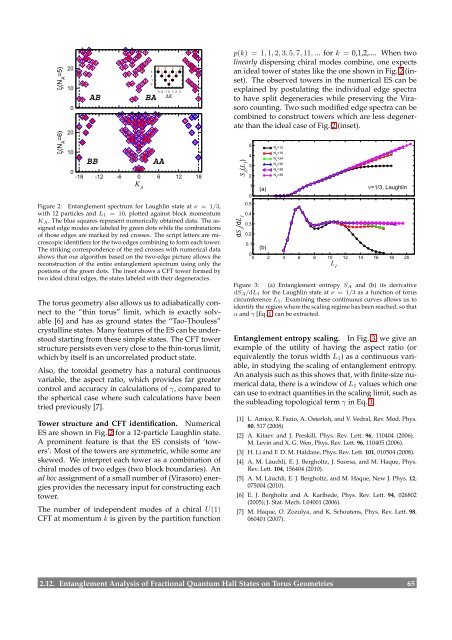Contents - Max-Planck-Institut für Physik komplexer Systeme
Contents - Max-Planck-Institut für Physik komplexer Systeme
Contents - Max-Planck-Institut für Physik komplexer Systeme
Create successful ePaper yourself
Turn your PDF publications into a flip-book with our unique Google optimized e-Paper software.
ξ(N A =5)<br />
ξ(N A =6)<br />
20<br />
10<br />
0<br />
20<br />
10<br />
BB<br />
3 2 2 3<br />
2 1 2<br />
1 1<br />
1<br />
-3 -2 -1 0 1 2 3<br />
∆K<br />
0<br />
-18 -12 -6 0<br />
K<br />
A<br />
6 12 18<br />
3<br />
2<br />
1<br />
0<br />
AB BA<br />
AA<br />
Figure 2: Entanglement spectrum for Laughlin state at ν = 1/3,<br />
with 12 particles and L1 = 10, plotted against block momentum<br />
KA. The blue squares represent numerically obtained data. The assigned<br />
edge modes are labeled by green dots while the combinations<br />
of those edges are marked by red crosses. The script letters are microscopic<br />
identifiers for the two edges combining to form each tower.<br />
The striking correspondence of the red crosses with numerical data<br />
shows that our algorithm based on the two-edge picture allows the<br />
reconstruction of the entire entanglement spectrum using only the<br />
postions of the green dots. The inset shows a CFT tower formed by<br />
two ideal chiral edges, the states labeled with their degeneracies.<br />
The torus geometry also allows us to adiabatically connect<br />
to the “thin torus” limit, which is exactly solvable<br />
[6] and has as ground states the “Tao-Thouless”<br />
crystalline states. Many features of the ES can be understood<br />
starting from these simple states. The CFT tower<br />
structure persists even very close to the thin-torus limit,<br />
which by itself is an uncorrelated product state.<br />
Also, the toroidal geometry has a natural continuous<br />
variable, the aspect ratio, which provides far greater<br />
control and accuracy in calculations of γ, compared to<br />
the spherical case where such calculations have been<br />
tried previously [7].<br />
Tower structure and CFT identification. Numerical<br />
ES are shown in Fig. 2 for a 12-particle Laughlin state.<br />
A prominent feature is that the ES consists of ‘towers’.<br />
Most of the towers are symmetric, while some are<br />
skewed. We interpret each tower as a combination of<br />
chiral modes of two edges (two block boundaries). An<br />
ad hoc assignment of a small number of (Virasoro) energies<br />
provides the necessary input for constructing each<br />
tower.<br />
The number of independent modes of a chiral U(1)<br />
CFT at momentum k is given by the partition function<br />
p(k) = 1,1,2,3,5,7,11,... for k = 0,1,2,.... When two<br />
linearly dispersing chiral modes combine, one expects<br />
an ideal tower of states like the one shown in Fig. 2 (inset).<br />
The observed towers in the numerical ES can be<br />
explained by postulating the individual edge spectra<br />
to have split degeneracies while preserving the Virasoro<br />
counting. Two such modified edge spectra can be<br />
combined to construct towers which are less degenerate<br />
than the ideal case of Fig. 2 (inset).<br />
S A (L 1 )<br />
dS A /dL 1<br />
5<br />
4<br />
3<br />
2<br />
1<br />
0<br />
0.5<br />
0.4<br />
0.3<br />
xxxxx xxxxxx xxxxx<br />
xxxxxxx xxxxx<br />
xx xx<br />
xxxx x xxx<br />
xxxxx xxxxx<br />
xxxxxx xx<br />
x x xxxxxx<br />
N =12 s xxxxx N =18<br />
xxxxxxxx s<br />
N =24<br />
xx<br />
s<br />
N =30<br />
s<br />
xxxN<br />
=36<br />
s<br />
xxxN<br />
=39<br />
s<br />
ν=1/3, Laughlin<br />
(a)<br />
xx<br />
xxxxx<br />
xx<br />
x<br />
xx xxxxxxxxxxxxxxxxxxxxxxx<br />
xx xx<br />
xxxx<br />
xx xx xx xx<br />
0.2<br />
xx<br />
0.1<br />
0<br />
0<br />
(b)<br />
2<br />
xx<br />
xx<br />
4 6 8 10<br />
L<br />
1<br />
12 14 16 18 20<br />
Figure 3: (a) Entanglement entropy SA and (b) its derivative<br />
dSA/dL1 for the Laughlin state at ν = 1/3 as a function of torus<br />
circumference L1. Examining these continuous curves allows us to<br />
identify the region where the scaling regime has been reached, so that<br />
α and γ [Eq. 1] can be extracted.<br />
Entanglement entropy scaling. In Fig. 3, we give an<br />
example of the utility of having the aspect ratio (or<br />
equivalently the torus width L1) as a continuous variable,<br />
in studying the scaling of entanglement entropy.<br />
An analysis such as this shows that, with finite-size numerical<br />
data, there is a window of L1 values which one<br />
can use to extract quantities in the scaling limit, such as<br />
the subleading topological term γ in Eq. 1.<br />
[1] L. Amico, R. Fazio, A. Osterloh, and V. Vedral, Rev. Mod. Phys.<br />
80, 517 (2008)<br />
[2] A. Kitaev and J. Preskill, Phys. Rev. Lett. 96, 110404 (2006).<br />
M. Levin and X. G. Wen, Phys. Rev. Lett. 96, 110405 (2006).<br />
[3] H. Li and F. D. M. Haldane, Phys. Rev. Lett. 101, 010504 (2008).<br />
[4] A. M. Läuchli, E. J. Bergholtz, J. Suorsa, and M. Haque, Phys.<br />
Rev. Lett. 104, 156404 (2010).<br />
[5] A. M. Läuchli, E. J. Bergholtz, and M. Haque, New J. Phys. 12,<br />
075004 (2010).<br />
[6] E. J. Bergholtz and A. Karlhede, Phys. Rev. Lett. 94, 026802<br />
(2005); J. Stat. Mech. L04001 (2006).<br />
[7] M. Haque, O. Zozulya, and K. Schoutens, Phys. Rev. Lett. 98,<br />
060401 (2007).<br />
2.12. Entanglement Analysis of Fractional Quantum Hall States on Torus Geometries 65
















